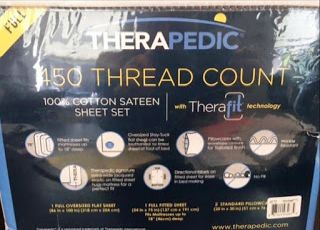The Board affirmed a refusal to register the mark THERAFIT for "bed sheets," agreeing with Examining Attorney David I that applicant's specimen failed to show the mark in use in connection with the goods. Instead, the Board found that "[t]he mark will be perceived as identifying the elastic component of the bed sheets and not the overall finished sheets without regard to any of their particular features." In re Ther-A-Pedic Associates, Inc., Serial No. 86983542 (September 13, 2019) [not precedential] (Opinion by Judge Frances Wolfson).

Applicant's specimen of use (above) depicted packaging for the goods and displayed the phrase "with THERAFIT technology." The critical issue, of course, was how the word THERAFIT would be perceived by the relevant consuming public. In order to function as a trademark, "Applicant's mark must be associated with the goods and signify to purchasers the source of the goods sold or offered for sale."
The Board found that the relevant size and placement of the wording, including the mark THERAPEDIC followed by the registration symbol, "gives the impression" that the THERAPEDIC mark "identifies the sheet set as a whole." The relatively small size and placement of THERAFIT "contribute to it being perceived as identifying the elastic feature of the sheets, rather than the sheets themselves." Also, the design element incorporating the term "fit" suggests the elasticized corners of the fitted sheets.
Applicant argued that the goods fall in class 24 (the classification for the finished product), since the elastic cannot be "disassociated" from the sheets. The Board was unmoved. "Classification is assigned according to the goods as identified in the application, and is not indicative of whether the specimen shows use of the designation as a trademark for the identified goods."
The Board concluded that consumers "will not directly associate the proposed mark with the involved goods such that it would indicate the source of the goods."
The content of this article is intended to provide a general guide to the subject matter. Specialist advice should be sought about your specific circumstances.

